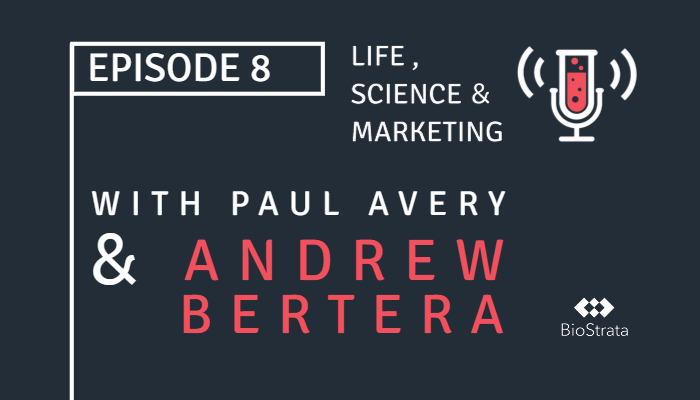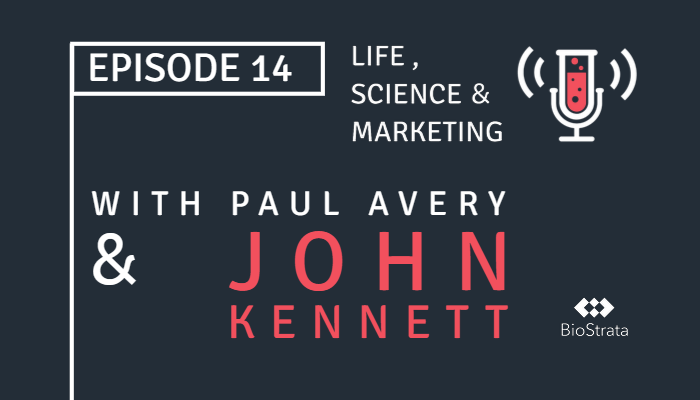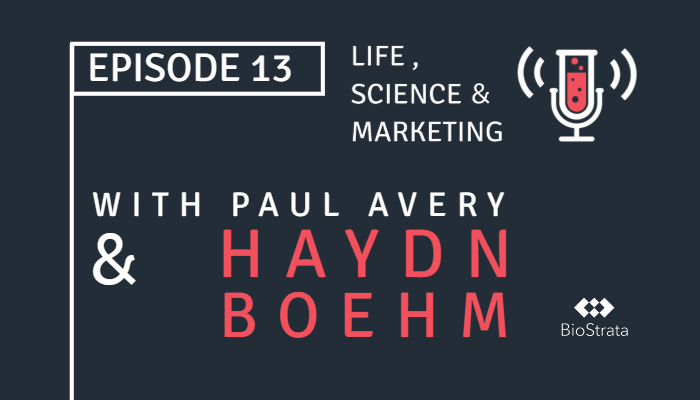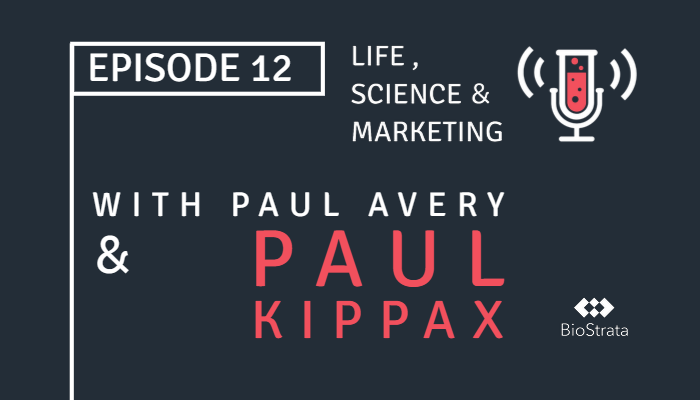Andrew Bertera: Combining scientific expertise with marketing and sales leadership, fostering cross-functional empathy, and keeping the customer at the centre
Our "Life, Science and Marketing" podcast features insightful discussions between host and BioStrata CEO Paul Avery and top marketing leaders across the life sciences industry. In each episode, guests share their backgrounds, experiences, and advice on marketing strategies and best practices.
In episode 8, Paul had an in-depth conversation with Andrew Bertera, Executive Director of Marketing and Sales at New England BioLabs. With deep scientific training coupled with extensive marketing and sales leadership experience, Andrew discussed how he has progressed his commercial skills while always keeping science and the customer at the centre. He offered valuable perspectives on moving from R&D into marketing, leading unified marketing and sales teams, embracing technology while still connecting with customers, and continually enhancing the customer experience.
Read on for a summary of episode 8 and Andrew's insights on combining scientific expertise with marketing and sales acumen, fostering cross-functional empathy, and never losing sight of the customer as the key to success in life science marketing. You can also listen to their full discussion in the podcast episode below or find us on your favourite podcast platform.
Can you walk us through your career journey and how you got to where you are today?
Andrew Bertera: I grew up in Newport, Wales and studied microbiology at King's College London. After graduating, I joined Amersham in R&D developing products for molecular biology applications. I found great satisfaction in commercialising these products and talking with customers about how they used them. This led me into marketing roles, starting in product marketing at Amersham.
I spent 7 years as a product marketing manager before moving to the US for a 4-year assignment leading marketing for Amersham's cell biology business. After Amersham was acquired by GE, I left to join Promega as head of marketing, rebuilding their team.
4 years later, New England Biolabs recruited me to lead global marketing and sales. I've now been at NEB for 14+ years in this combined commercial role. It's been a progressive career focused on science and customers, while advancing my marketing and leadership skills. The customer centricity and hands-on marketing experiences early in my career drove my path to sales and executive leadership positions.
How was the transition from working in R&D to marketing roles? What appealed to you about marketing as a career?
Andrew Bertera: My early days in marketing at Amersham were very hands-on as the only marketing person on site. I could literally shout questions to the lab down the hall to get answers for customers and salespeople. It made me look better than I was at the time! But it gave me great on-the-job learning applying my scientific background to think about marketing like experiments – what data could I collect, what tactics could I test?
Most of my early marketing learning was bottom-up and experiential. I think it's often easier for scientists to become marketers than the other way around. What you're providing is tools to apply your existing knowledge and experience, tailored to the job at hand. But to truly understand topics like molecular biology requires deep scientific expertise, given the complexity.
I've always had a sales target, which connected marketing to the end goal of driving sales. Seeing the results of all your marketing efforts is the best metric you can get. And I got great satisfaction from commercialising the products I helped develop in R&D and seeing them be successful. That led me into marketing and I've never looked back.
What was it like moving from marketing only roles into combined marketing and sales leadership positions? What key lessons did you learn from this?
Andrew Bertera: At New England Biolabs, both marketing and sales report to me. This was appealing as it allowed me to really get the teams working closely together. They face a lot of the same challenges, they just use different language and analogies to explain them. When they report to the same leader it's easier to set unified goals and get them collaborating in the field.
I bring salespeople into our quarterly planning meetings where we review tactics and sales results from the prior quarter. This gives them visibility into the marketing perspective and thought process. I also have our CRM system generate random customer inquiries and interactions for me to review each week, to monitor the quality of experience we're delivering.
On the sales side, I get a weekly report of any ageing open customer inquiries to catch situations where the ball was dropped. Most of the time it's just the case wasn't closed, but occasionally an email fell through the cracks. Simple things like this help connect the teams and ensure we live up to our brand promise.
There's always some natural tension between sales and marketing. But we ultimately all exist to deliver solutions to customers, even though we divide into functional groups to organise the business. The more empathy marketing has for sales, and vice versa, the better. Getting them out in front of customers together is invaluable.
How do you think technology has influenced marketing over the course of your career?
Andrew Bertera: The single biggest change is accessibility to customer data, especially for segmentation, targeting and personalisation. In the past, we just blasted messages out en masse. Now we can really understand who we're marketing to and tailor communications accordingly.
That said, technology is a double-edged sword. Sometimes print is still preferred over digital in labs – scientists want physical protocols at the bench. We're still trying to determine how best to connect mobile, digital and physical experiences. For example, we tried using QR codes to let customers scan and pull up protocols on their phones. But adoption was non-existent, even though protocol downloads are popular on our website. Screens aren't great for reading protocols at the bench.
While digital experiences are important, we don't have the depth of consumer data in life sciences. We know more about our customers' work than about them as individuals. We're trying to understand how scientists will use mobile going forward, but it's their personal device also used at home. There's tension between work and life uses that consumer companies don't face to the same degree.
In your view why is customer centricity and focus so important for marketers? How do you strive to ensure this in your current role?
Andrew Bertera: To me, marketing is about growing the business by developing best-in-class customer experiences. Growth ties marketing to sales and the health of the business. And "customer experience" takes marketing out of just being a department - anyone who impacts customers is doing marketing, whether customer service, tech support, shipping etc.
I regularly review random customer interactions to monitor quality. We empower customer service to immediately replace any damaged products, rather than making customers wait on approvals. I also travel with sales reps which is very humbling, when you see your carefully crafted marketing materials being used and realise the message doesn't quite come across as intended.
Directly interacting with customers is critical to truly understand them. Surveys alone don't uncover insights like face-to-face conversations can. And watching customers use your products reveals tips and tricks you'd never expect but can leverage. Customer experience and centricity drive differentiation and are vital for marketing today.
What are your perspectives on trade shows? How do you aim to maximise value and ROI from trade shows?
Andrew Bertera: The customer interactions are still vital. Presenting helps drive booth traffic, then the booth becomes a meeting place. Planning customer and media meetings in advance maximises value, since you're all there anyway. But true value is hard to quantify due to the attribution gap - rarely is a single interaction responsible for a sale in life sciences.
I see trade shows as one part of the marketing mix to use carefully. They are expensive, so you must multitask - media interviews, business meetings etc. But bringing many customers together in one place provides opportunities, if you plan and execute well. The jury is still out on the future role of shows in the digital age. I had hoped they would become less important as they are costly. But they may be returning to full force post-pandemic.
Can you provide examples of how you have reinvigorated existing products over their lifecycle? What marketing techniques helped achieve this?
Andrew Bertera: We've enhanced restriction enzymes over decades by adding buffers, consolidating buffers, enabling use at one temperature, and adding loading dyes for visual tracking. These provide convenience and prevent price erosion, without changing the core product.
Packaging is another great way to add value without reformulating the product itself. We find better ways to package things that are easier for customers to use. Protocols are also important - improving protocols improves the customer experience.
Sometimes the simplest enhancements resonate most. Through small but thoughtful improvements over time, you can hold your price point and keep products fresh by understanding customer needs. It's an interesting challenge I enjoy.
The NEB catalog is a great example of content marketing - how has this helped build the NEB brand?
Andrew Bertera: The technical reference guides, not just the product listings, have allowed the catalog to live on in labs for decades. Customers keep old copies for the guides, protocols, tips and tricks relevant to their work. This expanded our presence and built brand affinity beyond what our market share commands.
We're bridging print and digital with QR codes to bring catalog pages to life through online content. But print still fills a unique role for scientists. The catalog creates a distinctive customer experience that boosts our brand. While the world is going digital, we still produce the catalog because it's a teaching aid and reference source that scientists want on their shelf.
If you had to give one best career tip to scientists interested in commercial roles, what would it be?
Andrew Bertera: Early in R&D, I learned the importance of customer insights driving product enhancements. We stabilised a radioactive reagent so it could be stored at room temperature. But customers didn't care about that - they liked the dye we added that made the radioactivity visible for safety and tracking.
Understanding how customers actually use your product can uncover unforeseen benefits and big opportunities. I've since been involved in many ethnographic studies directly observing scientists use products in ways you'd never expect. Don't assume you know how customers will use something - talk to them, survey them, ask dumb questions. Customer centricity has driven my career from R&D to leadership.
Discover more insights with the Life, Science & Marketing Podcast
As we conclude this in-depth discussion with Andrew Bertera, we'd like to thank him for openly sharing his extensive wisdom and experiences. Andrew enjoys engaging in further conversations, answering questions, and sharing more about his journey and expertise. You can connect with him on LinkedIn, where he actively participates in industry discussions.
We hope you enjoyed gaining insight into Andrew's perspective on combining scientific and commercial acumen, fostering cross-functional collaboration, and always keeping the customer at the centre of marketing strategy. Remember to stay tuned for future episodes of "Life, Science and Marketing" where we'll bring you more revealing discussions with top marketing leaders across the life sciences industry.
You can also follow the official Life, Science and Marketing LinkedIn page to keep up-to-date with the latest podcast news and episodes. We look forward to continuing the conversation and welcoming Andrew back in the future.




